Acer Predator Triton 17X (PTX17-71) review – Mini LED screen with an absurdly powerful hardware
Display quality, Health impact (PWM), Sound
Acer Predator Triton 17X (PTX17-71) is equipped with a touchscreen IPS panel, model number AUO B170QAN01.4 (AUO44A8). It comes with a 250Hz refresh rate and 1024 Mini LED dimming zones. Its diagonal is 17″ (43.2 cm), and the resolution – 2560 x 1600p. Additionally, the screen ratio is 16:10, the pixel density – 178 ppi, and their pitch – 0.14 x 0.14 mm. The screen can be considered Retina when viewed from at least 49 cm (from this distance, the average human eye can’t see the individual pixels).

Viewing angles are good. We offer images at different angles to evaluate the quality.
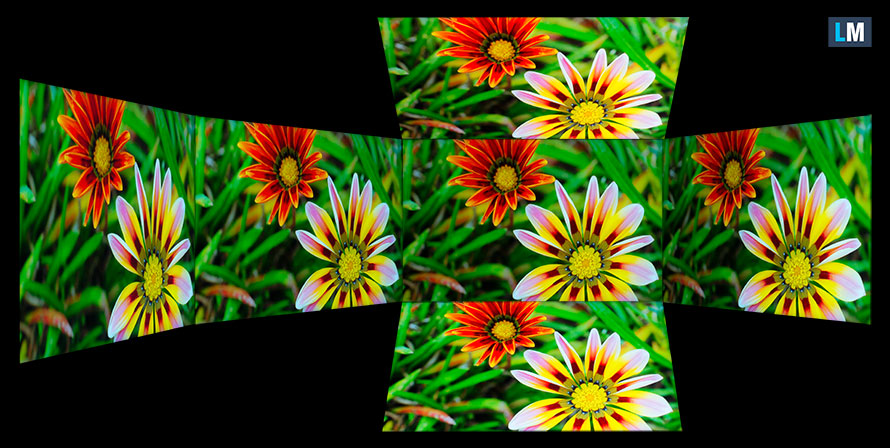
Also, a video with locked focus and exposure.
The maximum measured brightness depends on the content. With a 5% white and 95% black display, we measured 1100 nits (cd/m2). With a full white screen, the maximum brightness is 710 nits (cd/m2), while 11% white equals 814 nits (cd/m2) in the middle of the screen, and 806 nits (cd/m2) average across the surface with a maximum deviation of only 2%. The Correlated Color Temperature on a white screen and at maximum brightness is 6500K.
In the illustration below you can see how the display performs from a uniformity perspective. The illustration below shows how matters are for operational brightness levels (approximately 140 nits).
Values of dE2000 over 4.0 should not occur, and this parameter is one of the first you should check if you intend to use the laptop for color-sensitive work (a maximum tolerance of 2.0). We measured an ANSI contrast ratio of 36000:1 (Infinite contrast ratios can be achieved by devices capable of emitting no light at all as their darkest color).
To make sure we are on the same page, we would like to give you a little introduction to the sRGB color gamut and the Adobe RGB. To start, there’s the CIE 1976 Uniform Chromaticity Diagram that represents the visible specter of colors by the human eye, giving you a better perception of the color gamut coverage and the color accuracy.
Inside the black triangle, you will see the standard color gamut (sRGB) that is being used by millions of people on HDTV and on the web. As for the Adobe RGB, this is used in professional cameras, monitors, etc for printing. Basically, colors inside the black triangle are used by everyone and this is the essential part of the color quality and color accuracy of a mainstream notebook.
Still, we’ve included other color spaces like the famous DCI-P3 standard used by movie studios, as well as the digital UHD Rec.2020 standard. Rec.2020, however, is still a thing of the future and it’s difficult for today’s displays to cover that well. We’ve also included the so-called Michael Pointer gamut, or Pointer’s gamut, which represents the colors that naturally occur around us every day.
The yellow dotted line shows Acer Predator Triton 17X (PTX17-71)’s color gamut coverage.
Its display covers 100% of the sRGB/ITU-R BT.709 (web/HDTV standard) in CIE1976, and 100% of DCI-P3, resulting in a super vibrant and attractive picture.

We tested the accuracy of the display with 24 commonly used colors like light and dark human skin, blue sky, green grass, orange, etc.
Below you can compare the scores of the Acer Predator Triton 17X (PTX17-71) with the default settings and with our “Gaming and Web design” profile against the P3-D65 color space.
The next figure shows how well the display is able to reproduce really dark parts of an image, which is essential when watching movies or playing games in low ambient light.
The left side of the image represents the display with stock settings, while the right one is with the “Gaming and Web Design” profile activated. On the horizontal axis, you will find the grayscale, and on the vertical axis – the luminance of the display. On the two graphs below you can easily check for yourself how your display handles the darkest nuances but keep in mind that this also depends on the settings of your current display, the calibration, the viewing angle, and the surrounding light conditions.
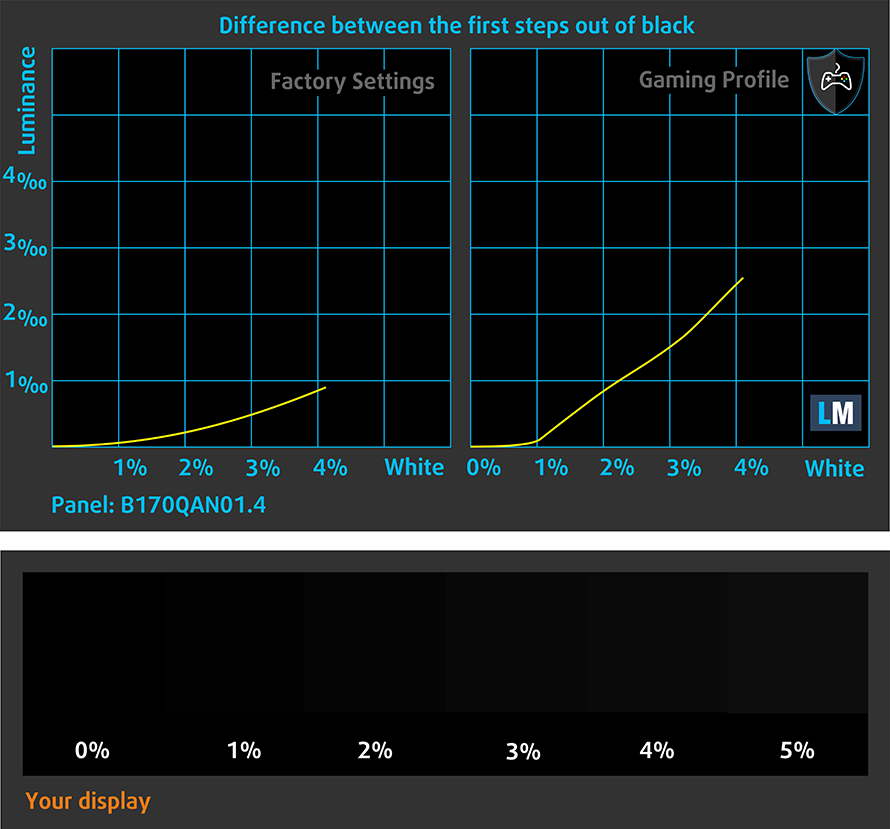
Health Impact: PWM (Screen flickering)
Pulse-width modulation (PWM) is an easy way to control monitor brightness. When you lower the brightness, the light intensity of the display is not lowered, but instead turned off and on by the electronics with a frequency indistinguishable to the human eye. In these light impulses, the light/no-light time ratio varies, while brightness remains unchanged, which is harmful to your eyes. You can read more about that in our dedicated article on PWM.
Acer Predator Triton 17X (PTX17-71)’s backlight has significant pulsations. Their frequency is high, but the filling coefficient is very low. The last segment of the chart below is from another display, which has a similar maximum brightness (440 cd/m2) but does not use PWM. This display might not be very comfortable for the more sensitive users. However, this technique will ensure a very sharp image in dynamic scenes.

Health Impact: Blue light emissions
Installing our Health-Guard profile not only eliminates PWM but also reduces the harmful Blue Light emissions while keeping the colors of the screen perceptually accurate. If you’re not familiar with the Blue light, the TL;DR version is – emissions that negatively affect your eyes, skin, and your whole body. You can find more information about that in our dedicated article on Blue Light.
Health Impact: Gloss-level measurement
Glossy-coated displays are sometimes inconvenient in high ambient light conditions. We show the level of reflection on the screen for the respective laptop when the display is turned off and the measurement angle is 60° (in this case, the result is 66.1 GU).
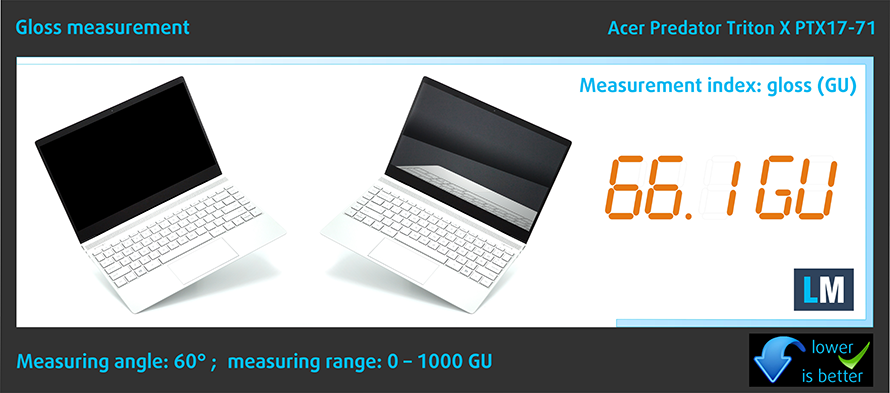
Sound
Acer Predator Triton 17X (PTX17-71)’s speakers produce a sound of decent quality. Its low, mid, and high tones are clear of deviations. However, the sound is a bit flat in our opinion.
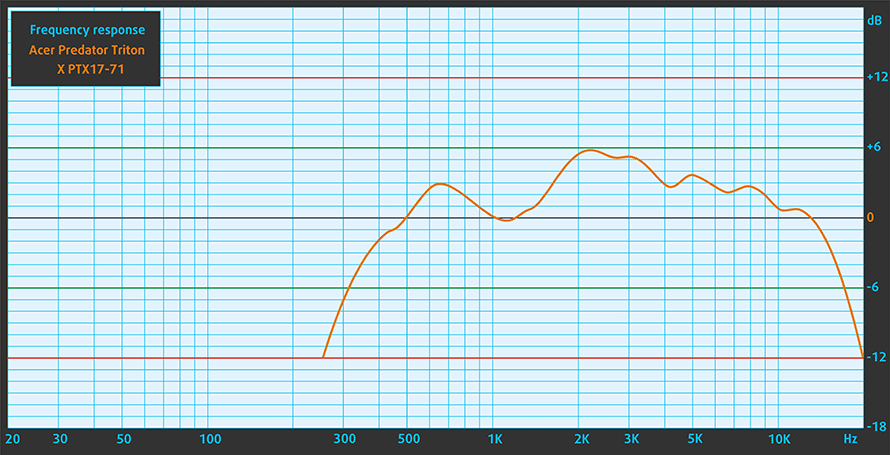

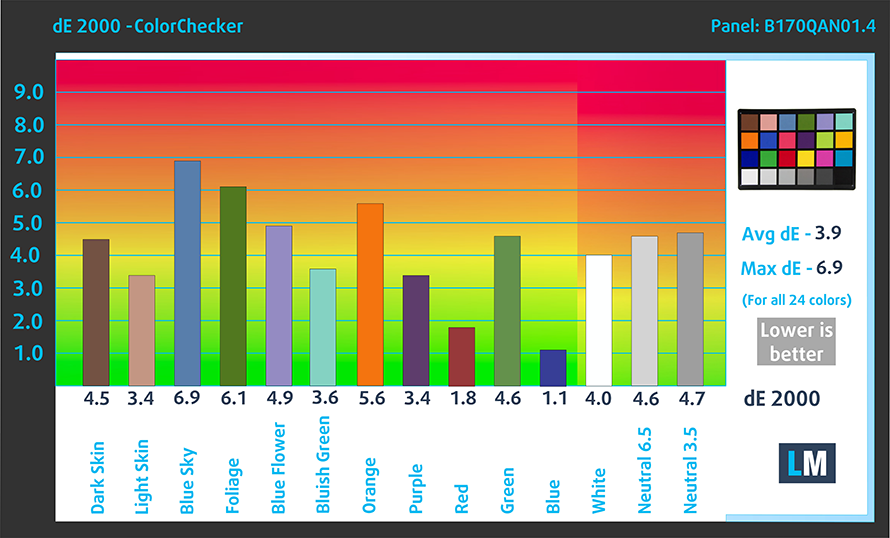
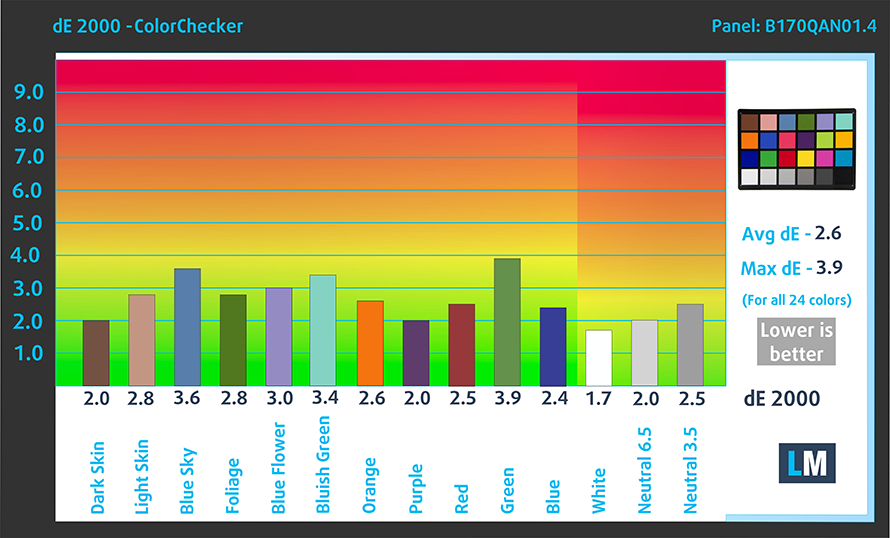








I have one of these on order. I couldn’t find any information if it has a Mux switch and thank goodness you mentioned it at the end of your view. So Thank you.
I am sadden by the lackluster performance. How and which mode is used? Are they hitting thermal throttling or power limit? Which mode was used for all the benchmarking?
As I recall the 2023 Asus Zephyrus Duo 16 only does the 175w CPU+GPU if it is in Turbo mode. Could it be possible Acer only allows 175w on CPU+GPU the same way?
Any updates on your purchase?